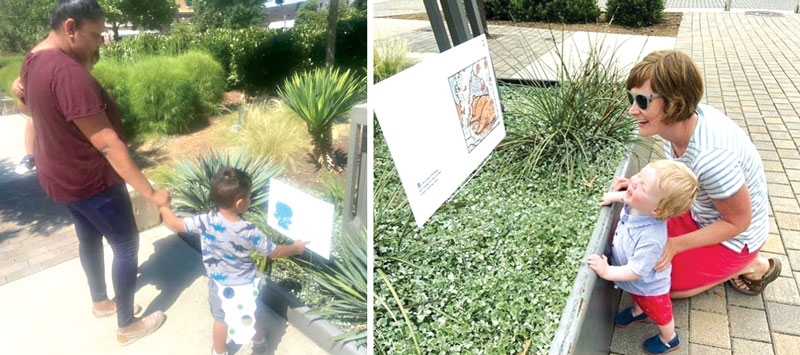Public Libraries Get Innovative for Playtime
The pandemic couldn't stop these libraries from offering fun learning experiences for the youngest patrons.

Story time at Bee Cave (TX) Public Library is immensely popular, regularly drawing a crowd of 100. When COVID-19 forced the library to shut its doors, Melissa Blackwell Burke, the youth services specialist, wanted to keep story time going without putting it online and adding to the glut of screen time options for the city’s youngest children. Story time became StoryWalk, a program that incorporates several fundamentals for early learning: reading, talking, playing, and parent involvement. Plus, it gets children outside, where there is plenty of space for social distancing.
Every month, the pages of a different picture book are laminated, attached to wooden posts at a child’s eye level, and staked into the ground about 40 paces apart in the green space in front of the library. The instructions to parents are brief and straightforward: “We just said, ‘Walk along and read the story page-by-page.’ ”
When kids are done reading, there is one more post containing take-and-make kits with a craft related to the story.
All the activities at Bee Cave are play-based and urge parents to encourage their children to use their imagination.
“I think we’ve just made it very front and center that play is the important work of children,” says Blackwell Burke. Years of research support her philosophy.
The challenge for many other libraries during the pandemic was maintaining a virtual, play-based environment. Marsha Gallardo, the children’s librarian and library programming coordinator, and Jessica Gray, the teen programming coordinator at Spring Hill Library near Nashville, aimed for unabashed silliness that breaks the fourth wall of the computer screen between the librarians and the children.
Gallardo says Gray “knocked it out of the park” by choosing Nick Caruso and Dani Rabaiotti’s Does It Fart?: A Kid’s Guide to the Gas Animals Pass. Gray didn’t realize how many children were watching until she became a minor celebrity around town. “Kids recognized me, they were so excited; I was the farting librarian,” says Gray, who has four sons and knows a little about how to grab their attention.
In keeping with the animal theme—and, possibly, the gross-out factor—Spring Hill Library has lined up an animal guy to host Zoom webinars this summer. Using his own menagerie that includes a kangaroo, an owl, snakes, and a balloon frog, he will discuss animal characteristics and what can be learned from them, such as friendship and loyalty.
Gallardo’s overarching focus in early learning programming is critical thinking skills, which are honed during this period of phenomenal brain development.
Family Place Libraries were an early leader in play-based library programming. Nearly a quarter century ago, Sandra Feinberg transformed the Middle Country Library in Centereach, NY, where she worked, into a community hub for young children and their parents. In addition to story time, she brought in nutritionists, social workers, and other resources to provide parents with information on child development and give them a safe space to talk with other new parents. At first, she was “shunned by most of the other library professionals,” she told the New York Times.
Today, about 550 libraries in 32 states have sent their children’s programming staff to New York for training as part of the certification required for an institution to call itself a Family Place Library. Staffers learn how to run workshops for parents and caregivers that cover developmental topics ranging from nutrition to potty training. The libraries must also commit to creating a large, specially designed early childhood space with toys, manipulatives, dramatic play items, seating for parents, and, of course, books. The space must be open whenever the library is open, and it must be accessible to children with special needs.
Spring Hill Library, a certified Family Place Library, is installing a communication board to help make the library more inclusive for nonverbal children.
“They are designed to help all kids, but specifically kids who are nonverbal, to communicate with peers and adults around them, and communicate their wants and needs, but also have a way to be social,” says Allyssa VelDink, a speech language pathologist who has designed three other communication boards that are in local Spring Hill parks.
The communication board is metal and will have plexiglass on top of it to make sure it is easy to clean and does not get worn down from use. It is five feet by three feet, with seven rows and eleven columns of squares with pictures of familiar objects and symbols that children point to to express emotions or needs, such as needing to use the bathroom, being hungry, or wanting to leave.
Pictures of locations around the library will also be included. There is also an alphabet so children can spell out a question or join in a conversation with other kids.
“They’re pretty simple,” says VelDink. “The symbols are stick drawings, they’re in color, and even if you don’t read or write, you’re able to infer what the picture is talking about.”
Early learning programs at Spring Hill library are messy, loud, a bit chaotic—“controlled chaos” says Gallardo—and occasionally unconventional.
“I’m often asked, ‘How do you come up with your ideas?’ It’s not like I’m in a search of an idea, I’m going to back to 'Why?' Why do this? My why is to be kind and understanding to children, to build their confidence, validate their childhood.”
Kathryn Baron is an education reporter based in California.
RELATED
The job outlook in 2030: Librarians will be in demand
The job outlook in 2030: Librarians will be in demand
ALREADY A SUBSCRIBER? LOG IN
We are currently offering this content for free. Sign up now to activate your personal profile, where you can save articles for future viewing





Add Comment :-
Be the first reader to comment.
Comment Policy:
Comment should not be empty !!!